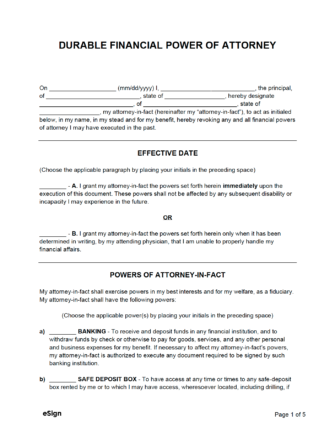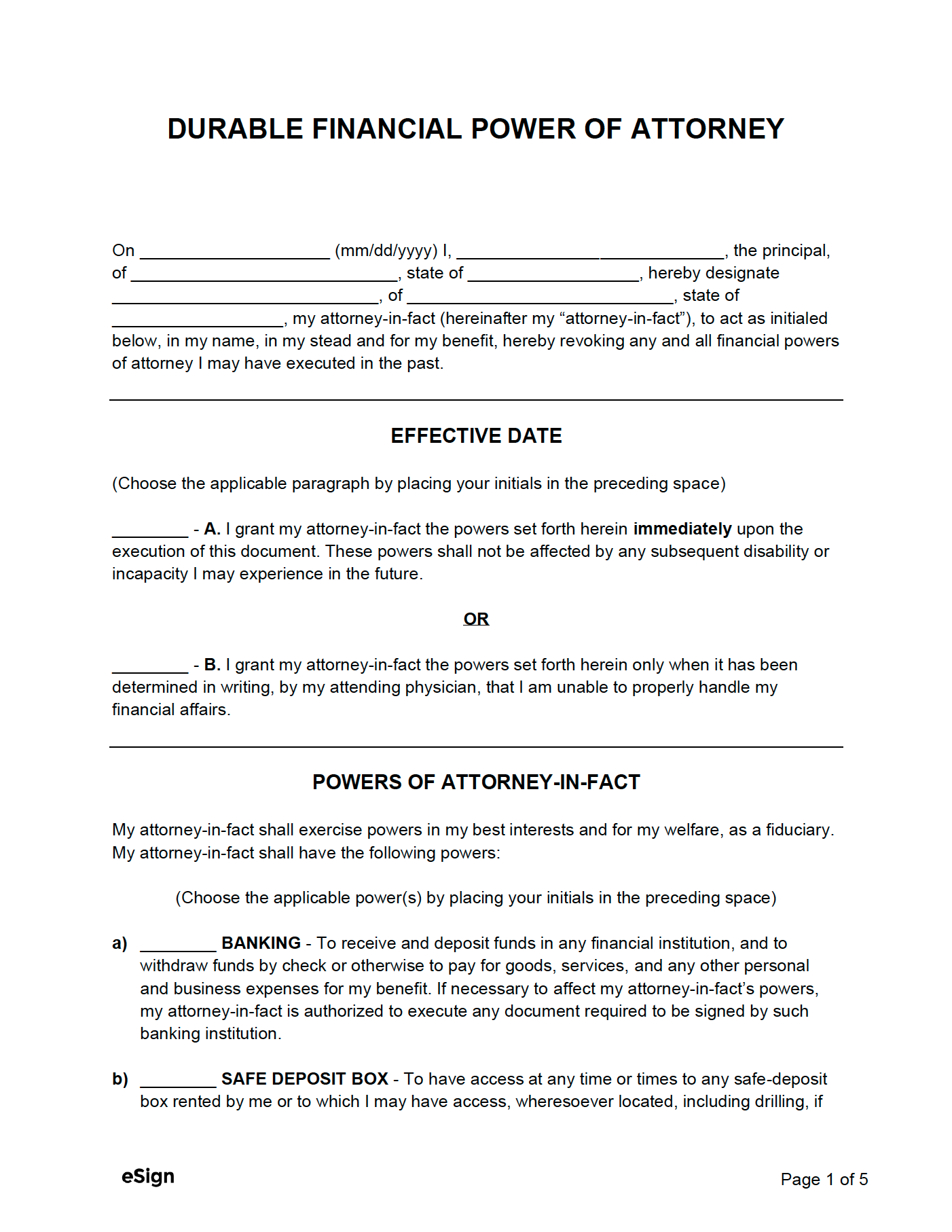Document Features
- Durability – States that the agent’s powers remain in effect even if the principal becomes disabled or incapacitated and unable to communicate.
- Powers – Enables the principal to select which powers their agent will have and to include special instructions and details to be added.
- Authority – Defines the agent’s authority so third parties will recognize and honor it without repeated confirmation from the principal.
- Effective Date – Establishes whether the agent’s powers go into effect when the principal signs the form or if the principal becomes incapacitated.
- Validity – Ensures the document is legally binding through the principal’s signature, notarization, witness attestation, and the agent’s acceptance.
By State
- Alabama
- Alaska
- Arizona
- Arkansas
- California
- Colorado
- Connecticut
- Delaware
- Florida
- Georgia
- Hawaii
- Idaho
- Illinois
- Indiana
- Iowa
- Kansas
- Kentucky
- Louisiana
- Maine
- Maryland
- Massachusetts
- Michigan
- Minnesota
- Mississippi
- Missouri
- Montana
- Nebraska
- Nevada
- New Hampshire
- New Jersey
- New Mexico
- New York
- North Carolina
- North Dakota
- Ohio
- Oklahoma
- Oregon
- Pennsylvania
- Rhode Island
- South Carolina
- South Dakota
- Tennessee
- Texas
- Utah
- Vermont
- Virginia
- Washington
- West Virginia
- Wisconsin
- Wyoming
Glossary
Agent (or Attorney-in-Fact): The person the principal chooses to act on their behalf.
Incapacity: The state of being mentally or physically unable to manage one’s own affairs.
Principal: The person who creates the POA and appoints an agent to represent them.
Durable Power of Attorney: Purpose and Use
A durable power of attorney allows a person to appoint someone they trust to serve as their agent and act on their behalf in financial transactions. Unlike a general financial POA, a durable power of attorney does not terminate upon the principal’s incapacity.
Individuals may choose to make their power of attorney durable to ensure their finances are managed during medical emergencies or in later life to assign a family member or friend to manage their affairs when they are no longer able to do so.
When a Durable POA Begins and Ends
A durable power of attorney begins immediately upon signing or upon the principal’s incapacity, depending on how the document is written.
It ends when one of the following occurs:
- The principal dies
- The principal revokes the POA
- A court invalidates the document or removes the agent
Signing Requirements: By State
| Signing Requirements and Laws | ||
| STATE | SIGNING REQUIREMENTS | STATUTE |
| Alabama | Notarized | § 26-1A-105 |
| Alaska | Notarized | § 13.26.600 |
| Arizona | Notarized AND 1 Witness | § 14-5501(D) |
| Arkansas | Notarized | § 28-68-105 |
| California | Notarized OR 2 Witnesses | § 4121 |
| Colorado | Notarized | § 15-14-705 |
| Connecticut | Notarized AND 2 Witnesses | § 1-350d |
| Delaware | Notarized AND 1 Witness | § 49A-105(a) |
| Florida | Notarized AND 2 Witnesses | § 709.2105(2) |
| Georgia | Notarized AND 1 Witness | §§ 10-6B-5, 44-2-15 |
| Hawaii | Notarized | § 551E-3(b) |
| Idaho | Notarized | § 15-12-105 |
| Illinois | Notarized AND 1 Witness | 755 ILCS 45/3-3.6 |
| Indiana | Notarized OR 2 Witnesses | § 30-5-4-1(a)(4) |
| Iowa | Notarized | § 633B.105 |
| Kansas | Notarized | § 58-652(a)(3) |
| Kentucky | Notarized | § 457.050 |
| Louisiana | N/A | No statute |
| Maine | Notarized | § 5-905(1) |
| Maryland | Notarized AND 2 Witnesses | § 17-110(a) |
| Massachusetts | N/A | No statute |
| Michigan | Notarized OR 2 Witnesses | § 556.205(2) |
| Minnesota | Notarized (if principal cannot sign) | § 523.01 |
| Mississippi | N/A | No statute |
| Missouri | Notarized | §§ 404.705(1)(3), 442.150 |
| Montana | Notarized | § 72-31-305 |
| Nebraska | Notarized | § 30-4005 |
| Nevada | Notarized | NRS 162A.220(1) |
| New Hampshire | Notarized | § 564-E:105 |
| New Jersey | Notarized | §§ 46:2B-8.9, 46:14-2.1 |
| New Mexico | Notarized | § 45-5B-105 |
| New York | Notarized AND 2 Witnesses | GOB § 5-1501B |
| North Carolina | Notarized | § 32C-1-105 |
| North Dakota | N/A | No statute |
| Ohio | Notarized | § 1337.25 |
| Oklahoma | Notarized | 58 O.S. § 3005 |
| Oregon | N/A | No statute |
| Pennsylvania | Notarized AND 2 Witnesses | § 5601(b)(3) |
| Rhode Island | Notarized | § 18-16-2(b) |
| South Carolina | Notarized AND 2 Witnesses | § 62-8-105 |
| South Dakota | Notarized | § 59-12-4 |
| Tennessee | N/A | No statute |
| Texas | Notarized | § 751.0021 |
| Utah | Notarized | § 75A-2-105(1) |
| Vermont | Notarized | 14 V.S.A. § 4005 |
| Virginia | Notarized | § 64.2-1603 |
| Washington | Notarized OR 2 Witnesses | § 11.125.050 |
| West Virginia | Notarized | § 39B-1-105 |
| Wisconsin | Notarized OR 2 Remote Witnesses | § 244.05 |
| Wyoming | Notarized | § 3-9-105 |
How to Get a Durable Power of Attorney
Step 1 – Choose an Agent
It’s recommended that the agent be the principal’s spouse, family member, or close friend. The principal should also name one or more alternate agents to serve if the primary selection is unable.
Step 2 – Decide Powers
The principal must choose which powers to grant their agent, which often includes the ability to conduct business transactions, file taxes, apply for government benefits (e.g., Social Security, Medicare), and buy, sell, or manage real estate.
Step 3 – Grant Specific Authority
In states that have adopted the Uniform Power of Attorney Act, the principal must explicitly state in the POA form whether the agent is authorized to perform acts beyond the typical financial powers granted, such as the power to:
- Create, amend, revoke, or terminate an inter vivos trust.
- Make gifts.
- Create or change rights of survivorship.
- Create or change a beneficiary designation.
- Authorize another person to be an agent.
Step 4 – Sign the Form
The signing requirements of the principal’s state of residence must be followed. Generally, a durable POA must be signed by the principal and notarized, with some states also requiring the signatures of two witnesses.
Step 5 – Act as an Agent
Once a durable POA form is completed and signed, the agent may begin acting on the principal’s behalf. The agent should keep a copy of the form accessible, as banks, government agencies, and other institutions will require proof of authorization.
Sample
DURABLE FINANCIAL POWER OF ATTORNEY
I, [PRINCIPAL NAME], the Principal (hereinafter “Principal”), of [PRINCIPAL ADDRESS], hereby designate [AGENT NAME], of [AGENT ADDRESS], my Attorney-in-Fact (hereinafter “Attorney-in-Fact”), to act as initialed below, in my name, in my stead and for my benefit, hereby revoking any and all financial powers of attorney I may have executed in the past.
1. EFFECTIVE DATE. I grant my Attorney-in-Fact the powers set forth herein: (initial one)
[INITIALS] – Immediately upon the execution of this document. These powers shall not be affected by any subsequent disability or incapacity I may experience.
[INITIALS] – Only when it has been determined in writing, by my attending physician, that I cannot handle my financial affairs properly.
2. POWERS. My Attorney-in-Fact shall have the following powers: (initial all that apply)
[INITIALS] – Power to Make Payments or Collect Monies Owed
[INITIALS] – Power to Acquire, Lease, and Sell Personal Property
[INITIALS] – Power to Acquire, Lease, and Sell Real Property
[INITIALS] – Banking Powers
[INITIALS] – Motor Vehicle Transaction Powers
[INITIALS] – Tax Powers
[INITIALS] – Gift Making Powers
[INITIALS] – Lending and Borrowing Powers
[INITIALS] – Other: [DESCRIBE OTHER POWERS OR SPECIAL INSTRUCTIONS].
3. AUTHORITY. Any party dealing with my Attorney-in-Fact may rely fully on the authority granted in this document and is not required to verify how proceeds are used or question the Attorney-in-Fact’s actions. Anyone acting in good faith based on this authority shall not be held liable to me or my estate. I ratify all lawful acts taken under this power, and my Attorney-in-Fact may seek court enforcement to ensure its full effect.
4. LIABILITY. My Attorney-in-Fact shall not incur any liability to me under this power of attorney except for a breach of fiduciary duty.
5. AMENDMENT AND REVOCATION. I can amend or revoke this power of attorney through a writing delivered to my Attorney-in-Fact. Any amendment or revocation is ineffective as to a third party until such third party has notice of such revocation or amendment.
6. STATE LAW. This power of attorney is governed by the laws of the State of [STATE].
IN WITNESS WHEREOF, I have executed this power of attorney on [DATE].
Principal Signature: _____________________________
ACCEPTANCE OF APPOINTMENT
I, [AGENT NAME], the Attorney-in-Fact named above, hereby accept appointment as attorney-in-fact in accordance with the foregoing instrument.
Attorney-in-Fact Signature: _____________________________
WITNESS
We, the witnesses, each do hereby declare in the presence of the Principal that the Principal signed and executed this instrument in the presence of each of us, that the Principal signed it willingly, that each of us hereby signs this power of attorney as witness at the request of the Principal and in the Principal’s presence, and that, to the best of our knowledge, the Principal is eighteen years of age or over, of sound mind, and under no constraint or undue influence.
Witness Signature: _____________________________
Print Name: [WITNESS NAME] Address: [WITNESS ADDRESS]
Witness Signature: _____________________________
Print Name: [WITNESS NAME] Address: [WITNESS ADDRESS]
STATE OF [NOTARY: STATE]
COUNTY OF [NOTARY: COUNTY]
On [DATE], before me appeared [PRINCIPAL NAME], as Principal of this Power of Attorney who proved to me through government-issued photo identification to be the above-named person, in my presence executed the foregoing instrument and acknowledged that he/she executed the same as his/her free act and deed.
Notary Signature: _____________________________
Print Name: [NOTARY NAME]
My Commission Expires: [DATE] (seal)






